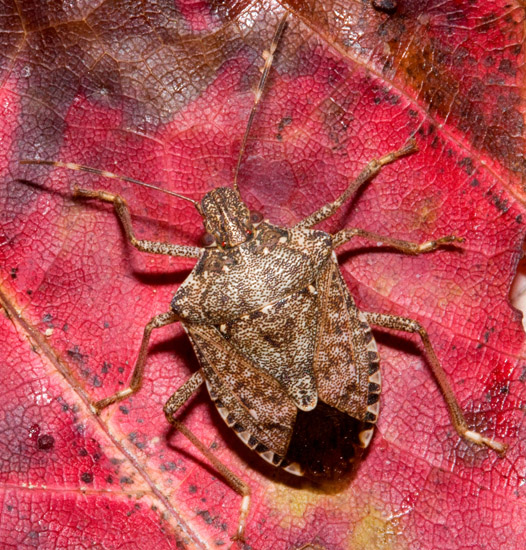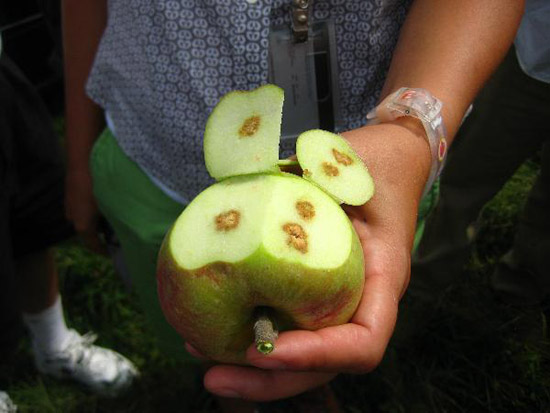Issue 1, April 18, 2011
Brown Marmorated Stink Bug Found in Illinois
The brown marmorated stink bug (BMSB) has been making headlines in Illinois the past couple of weeks. After the first confirmation of this invasive insect was reported in the fall of 2010 (Cook County), additional reports have continued to in 2011. In January, a homeowner reported an infestation in their home in Kane County, and just a couple of weeks ago, a homeowner in each of Normal (McLean County) and Urbana (Champaign) each submitted a single specimen for identification. Reports continue to circulate in northeastern Illinois.
Why is BMSB important?
Like many invasive species, BMSB has a long list of host plants, including many woody ornamental trees as well as several agricultural crops including fruit trees, grapes, tomatoes, corn, soybeans and others. Also, like many other invasive insects, it is easily moved from location to location by humans (hitchhiking on vehicles, movement of shipping materials, and movement of plants). In addition to feeding on plants, BMSB is also considered a nuisance pest to homeowners. Much like boxelder bugs or multi-colored Asian lady beetles, these stink bugs congregate on houses in late fall and move indoors. Homeowners are likely to first spot new infestations as these insects will initially feed on common landscape ornamentals.
How can I tell the difference between BMSB and other stink bugs found in Illinois?
Adult BMSB have the typical "shield" shaped body of all stink bugs. In reference to their name, they have a marmorated or mottled brown color. Their antennae have distinct white bands; on the edge of their abdomen they have alternating black and white bands. The underside of the abdomen is white and the legs may also have faint white banding.

Adult brown marmorated stink bug (Michael Jeffords).
When should I expect to see the BMSB?
Typically, the adults will begin to move to overwintering locations in September, with peak movement in late September and early October. Homeowners may start to see BMSB begin gathering on homes, barns, garages during this time. In the spring, adults will begin to emerge from their overwinter locations as temperatures begin to warm. After mating, eggs are laid on the undersides of leaves from June to August, with hatch occurring 3-7 days later. Nymphs will pass through 5 instars (each instar stage lasting about a week). New adults begin to appear in late July or August.
What kind of injury does BMSB cause?
Unlike many insect pests that only attack plants during certain times of the growing season, the BMSB will feed on host plants all season long. This causes great concern in fruit crops where they begin feeding early in the season and continue through harvest. Growers should monitor fruit for sunken areas where the insect has fed. These areas will be discolored and corky areas will be present under the skin of the fruit. In corn and soybean, BMSB feed on the developing pod or corn ear. They are able to feed through the husks and pods with their sucking mouthparts, causing shriveled kernels and beans, respectively. In tomatoes and peppers, feeding will also result in corky areas and discoloration, much like injury in fruit.

Damage caused by BMSB to apple (photo Maryland Department of Agriculture).

From left: brown marmorated stink bug on outside ear, kernal damage and tomato damage (David Wright: corn photos, Eric Day: tomato) (Virginia Cooperative Extension).
What do I do if I think I have the BMSB in my home/on my property?
We are very interested in where these insects may be and continue to try to determine their distribution in Illinois. If you believe you have a suspect specimen, we would be very interested in looking at it. To positively confirm any insect as BMSB, we need to look at an actual specimen. Suspect stink bugs may be sent to Kelly Estes, 1816 S. Oak St., Champaign, IL 61820. Please put stink bugs in a crush-proof container (pill bottle, check box, etc). You can also send a photo to kcook8@illinois.edu for preliminary screening if you wish. (Kelly Estes)
Author:
Kelly Estes